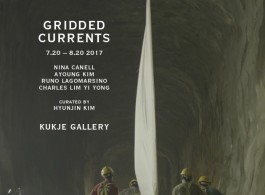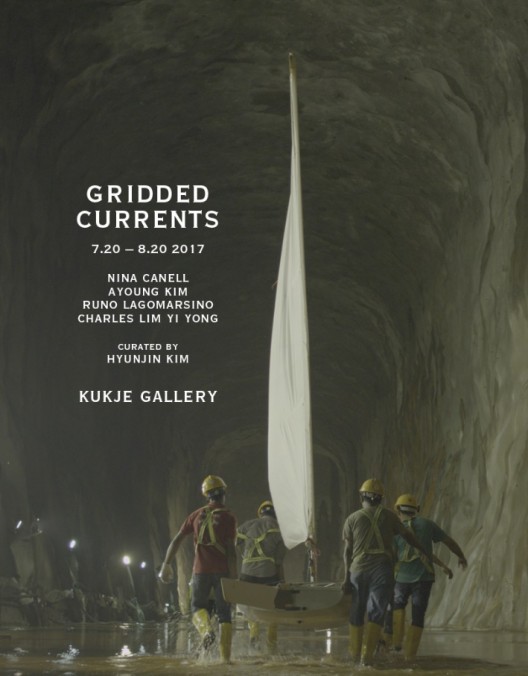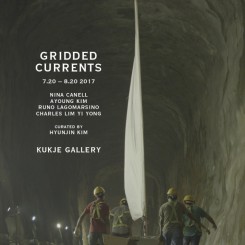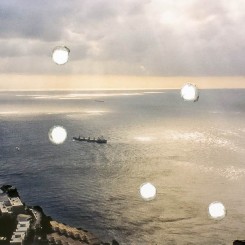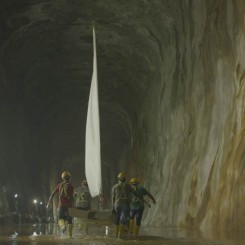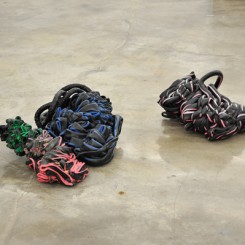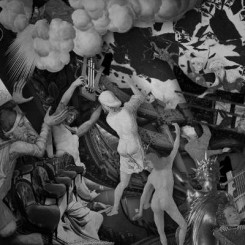Kukje Gallery, Seoul
20 July – 20 August, 2017
Press Conference: July 20 (Thurs.), 2017, 2PM at Kukje Gallery K2
Guest Curator: Hyunjin Kim
Participating Artists: Nina Canell, Ayoung Kim, Runo Lagomarsino, Charles Lim Yi Yong
Kukje Gallery is pleased to announce Gridded Currents, a group exhibition featuring four artists actively engaged in the global contemporary arts scene, from July 20 to August 20, 2017. Beginning with its 2013 exhibition The Song of Slant Rhymes, Kukje Gallery has been dedicated to curator driven shows with the aim of broadening the scope of the gallery’s exhibitions and artists. In keeping with this tradition, Kukje Gallery has invited the independent curator and art critic Hyunjin Kim to organize an exhibition introducing four artists from very different cultural and geographical backgrounds: Nina Canell, Ayoung Kim, Runo Lagomarsino, and Charles Lim Yi Yong.
The exhibition Gridded Currents explores how nature, in particular the sea, has been ruled and dominated by modernization, in the process of reifying and enforcing modernity’s border-making. The sea is no longer a neutral landscape as seen in this exhibition—rather, it approaches the ocean as a site of colonial history, a charged marker of national borders, and a target of capitalistic exploitation with its natural resources. Encompassing object installation, works on paper, wall installation, performance video, and film, the works of Nina Canell, Ayoung Kim, Runo Lagomarsino, and Charles Lim Yi Yong explore various aspects of modernity and other meta-narratives that maintain a distance from everyday reality but remain deeply embedded in the ocean’s depths. These historical arcs include forgotten or overlooked histories of imperialism and catastrophes as seen through gold and bitumen, struggles of the displaced, issues of nationalism and territorial dispute, and the network of hidden communication cables that crisscross the bottom of the ocean.
The sublime qualities of nature have been a favorite subject throughout the long history of painting. By the late 19th and early 20th century, when man began to systematically rule, categorize, control, and exploit nature, as epitomized by the grid or modern matrix, the majority of artists were still focused on the landscape as a means of representing nature. The sea, in particular, served as a popular subject evoking lyricism, as well as being a symbol of kitsch, owing to the fluidity and dynamic movements of its currents. The perennial desire of man to control nature was projected onto these images of dashing waves; the more powerfully an artist depicted a wave, the more profoundly he captured the spiritual sublime of mankind.
A century has passed and many artists today are no longer compelled to faithfully represent the dynamic movement of the currents through painterly expression. The sea is no longer seen as an innocuous scenery of waves, sunlight, and high winds, or a symbol for human desire to conquer the unruly nature. The artist Allan Sekula’s (1951-2013) visionary work Fish Story (1995) marks this seminal shift, approaching the ocean as a politically charged location dominated by the logics of global capitalist distribution and commerce. Just like Sekula’s vision and remarkable insight, many contemporary artists are keen to reflect the ocean not only as a place of global capital transaction and connection, but also as a brutal guarding site against the displaced. In this context, the sea is viewed as a marker of national boundaries and a catalyst for nationalistic competition; more recently, it is also a contested place for the construction of an invisible heavy industrial infrastructure, as embodied by hidden petrochemical pipelines and communication cables. The four artists in Gridded Currents alert us to the fact that the vast horizon of the ocean is in fact a set of gridded currents, using this metaphor to channel modernity through the marine environment in the contemporary era. In this reading, the sea is recognized as a territory on the map, a site that engenders capital hegemony, and a conduit for neo-liberal data processing. As vitally engaged fragments introducing this phenomenon, the works in the exhibition enable us to engage with this fraught history of modernity, confronting its lingering impacts. The artists’ varied works focus on these foundations and structures that remain invisible, hidden beneath the currents, providing an aesthetic and oblique passage into their critical investigations.
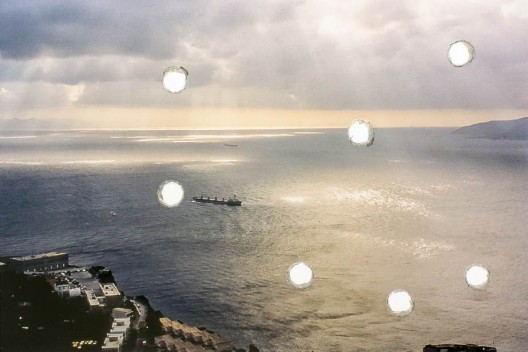
Runo Lagomarsino, Sea Grammar (detail), 2015
80 perforated images in a slide projection carousel
路诺-拉格马西诺,《大海的语法》细节图,2015年
80 perforated images in a slide projection carousel
Runo Lagomarsino (b. 1977)
Runo Lagomarsino utilizes poetic imagery and irony in his practice to reflect on the deeply rooted Eurocentrism that still exists today. His recent work explicitly confronts the history of imperialism beginning with Columbus, documenting its origins in European lust for gold and showing the resulting exploitation. From the late 15th century to the early 16th century, Columbus’ voyages to the “New World” were operations to find and exploit resources, converting stolen gold and other materials into capital. The ocean was an expanse that made the “discovery” of new land possible, giving rise to absurd fantasies and myths that gave a sheen of adventure to the imperial project of domination. Three works, installed on the first floor, allude to the pivotal significance of the ocean in the advent of colonialism, its abiding role in maintaining the logic of exploitation even today, and furthermore the monstrosity of it. Mare Nostrum Mare Mostrum (2015), meaning “Our Sea Our Monster” in Latin, features a large curtain printed with an image of a 16th century ship battling a sea monster that resembles the mythic creature known as the “Kraken.” The other two works Violent Corners (2014) and Europe is Impossible to Defend (2014) frame the long legacy of Eurocentrism and the violence that preceded the myth of “discovery.” Violent Corners is a minimal work that illuminates the two corners of the first floor with a vertical composition of gold leaf applied to the wall while Europe is Impossible to Defend is an illustration borrowed from the famous apocryphal story titled Egg of Columbus, which had a pivotal role in the mythologizing of Columbus as a creative and progressive hero.
On the second floor, Lagomarsino has installed two works that explore the Mediterranean Sea and its role in contemporary history. Sea Grammar (2015) features a projected loop consisting of eighty slides. As the slides switch one by one, scenes of the sea become increasingly punctured with holes; by the end of the loop the image of the Mediterranean is eclipsed, with only light from the projector remaining. Sea Grammar reminds the viewer of both historic and contemporary violations of human rights that have transpired on and near the water, challenging the common perception of the beach and coastal cities as places of recreation. While it evokes tranquility and beauty, Lagomarsino’s powerful work illustrates the raw violence that remains beneath the surface of the ocean. The artist takes pains to show how the ocean has historically functioned as a threshold promising new possibilities for immigrants, but that today, it is often an impenetrable barrier confronting exhausted refugees. Most recently, the Mediterranean in particular has become a body of water that large populations of refugees from regions such as Africa, Afghanistan, and Syria desperately struggle to cross. The banal sound of the slides slowly rotating on the carousel hint at the quiet reticence of Europeans faced with this tragedy.
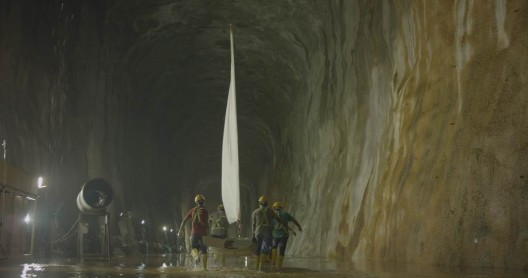
Charles Lim Yi Yong, SEA STATE 6: phase 1, 2015
Single-channel HD digital video
林育荣,《海況6: phase 1》 (SEA STATE 6: phase 1),2015年
单频道数码影像
Charles Lim Yi Yong (b. 1973)
Charles Lim Yi Yong is a former Olympic sailor. This background informs his unique sensitivity and interest in the ocean. Born in Singapore, Lim’s work encompasses film, installation, sounds, conversations, text, drawing, and photography. Since 2005, he has been developing a body of works titled SEA STATE, which explores the political, biophysical and psychic contours of Singapore through the visible and invisible lenses of the sea. The artist’s practice consists of extensive research on the maritime geography of Singapore and its history, examining the impact of mankind on the physical environment that surrounds nature and the interrelationship between nature and technology, land and sea.
The artist will exhibit a total of five works from SEA STATE. These include an image recording a sea wall along the northeast border regions of Singapore titled SEA STATE 4: line in the chart (2008) and SEA STATE 8: THE GRID (2014), which showcases maps of reclaimed land in Singapore. The artist explores the way Singaporeans perceive the sea not as an “expanse” or “open space,” but as a “wall,” where the waters are displaced by land reclamation. In this telling, the sea, an area where global maritime trade occurs, is being transformed into a barrier, marking a mood of isolation, division, and physical conquest based on inviolable national boundaries. A parallel case can be seen clearly in the territorial disputes surrounding the islands and seas between the East Asian countries of Korea, China, and Japan and Lim poignantly illustrates how the ocean in general has become a contested site sparking nationalistic competition.
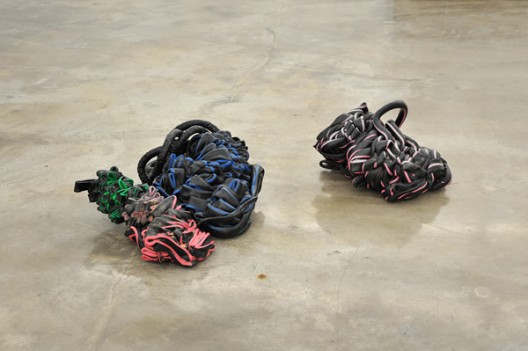
Nina Canell, Shedding Sheaths (H) (detail), 2015
Fiber-optic cable sheaths, concrete
尼娜·加奈尔,《Shedding Sheaths》 细节图,2015年
Fibre-optic cable sheaths, concrete
Nina Canell (b. 1979)
Nina Canell’s body of work can be described as a kind of “sculptural condition” that embodies both a state of stillness and of flux (as seen in natural phenomenon). Her works challenge traditional categories of sculpture using chemical and material interactions between mediums that measure the constant flux of their surroundings—illustrating the invisible and immaterial world that remains unseen to the naked eye.
Over the past couple of years, the artist has explored the role of fiber-optic cables in technology and the internet, exploiting the colorful exterior sheaths of recyclable cables collected from Lyon and the outskirts of Seoul to ruminate on the physicality of technology and its presence in our lives. While today’s increasingly digitized environment aspires to adopt a state of wirelessness, fiber-optic cables are still required and are found buried across the world and at the bottom of the ocean. This conceptual tension underlies the antinomic relationship of technology—a major leitmotif of the artist since her early works that featured a cross-section of the bulky fiber-optic cable as individual sculptures. In her work installed at Kukje Gallery, Canell will again use the cable body as an inchoate material by melting its plastic exterior sheath to remind the viewer of the body that remains embedded in the future, not only rendering the intangible passage of transmitted information tangible, but also revealing the latent cycle wherein plastic exterior sheaths continuously transition from one state to another.
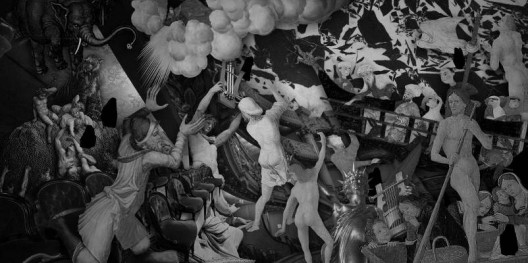
Ayoung Kim, Grand deuil (Deep Mourning) (detail), 2016
Digital print
金雅瑛,《Grand deuil (Deep Mourning)》 细节图,2016年
数码印刷
Ayoung Kim (b. 1979)
Ayoung Kim’s recent work considers the natural resources of the seas and deserts, reflecting on how oil has become the equivalent of gold in our contemporary era and how this phenomenon intertwines with the history of the Middle East. The artist realigns and fragments macro-histories of the Middle East alongside the modern Korean economic boom resulting from political and economic ties with the region, overlaying these with individual micro-histories from within these two countries, merging them to create a unique kind of cultural algorithm. The algorithm departs from meta-storylines and transforms into a disassembled and scattered narrative, highlighting the intersection, collision, and tension of language—librettos which Kim utilizes to create experimental chorus performances. Working in collaboration with the composer Heera Kim these compositions use unnatural sounds from a musical score similar to avant-garde opera. Kim is particularly interested in the myths and history of bitumen, commonly known as the base material of asphalt and a black, dark brown solid or viscous residue of refined petroleum. The history and use of naturally occurring bitumen dates long before the discovery of petroleum, and as described in the Bible, the substance was extracted from trees and used to coat the interior and exterior of Noah’s ark.
At Kukje Gallery Ayoung Kim will present Conducting Bitumen in an Infinite Loop (2014/2016), a video work featuring a conductor’s hand and an invisible choir that recounts the history of bitumen and its role up to modern civilization. The artist will also include a selection of works from last year’s solo exhibition In This Vessel We Shall Be Kept at the Palais de Tokyo. These works, inspired by catastrophes across human history such as the sea and the flood, along with man-made objects built as a protection against them, will be reconfigured for the Kukje Gallery exhibition space. Among the works featured is the commissioned series In This Vessel We Shall Be Kept, which takes place at the French national opera house Palais Garnier. Along with the collage of footage taken from the interior and exterior of the opera house and from stories found across ancient theological scriptures, Kim will also showcase a video work of the same title (2016) recording a staged performance at Palais Garnier as well as a diagram of her research process on the Gilgamesh flood myth titled Map for “In This Vessel We Shall Be Kept” (2016). The artist’s use of bitumen can be traced back to the tales of Noah’s Ark and The Great Flood. This series, however, provides a contemporary twist by framing the foundation of capitalism, religion, and civilizations in the geopolitics of oil and more broadly the procurement of natural resources.
About the Curator
Hyunjin Kim is a curator of contemporary visual arts and a writer and researcher based in Seoul. She was the Artistic Director at Arko Art Center, Seoul (2014‒15) and co-curator of the 7th Gwangju Biennale, Annual Report: A Year in Exhibitions (2008). Kim was also the Chief Curator of the Ilmin Museum of Art in Seoul, Researcher/Guest Curator at the Van Abbemuseum in Eindhoven, and Curator of Art Sonje Center in Seoul. She has curated numerous exhibitions including 2 or 3 Tigers (2017) at the Haus der Kulturen der Welt, Berlin, Two Hours (2016) at Tina Kim Gallery, New York, Satin Ions, Time Mechanics (2015), and Tradition (Un)Realized (2014) at Arko Art Center, Brilliant Collaborator (2013) at the Ilmin Museum of Art, Perspective Strikes Back (2010) at L’appartement 22, Rabat, Ten Years, Please and Movement, Contingency and Community (2007) at Gallery27, Uiwang, Sadong 30 (2007) featuring Haegue Yang in Incheon, Plug-In#3-Undeclared Crowd (2006) at the Van Abbemuseum. Since 2009, Kim has curated and produced performances with contemporary artists including Sung Hwan Kim’s In the Room 3 (2009) at Performa, New York, siren eun young jung’s (Off)Stage/Master class (2012-2013) at festival Bo:M, Seoul, Jewyo Rhii’s Ten Years (2016-2017) at Seoul Art Space Mullae and Namsan Arts Center, Seoul. Her published work includes Chung Seoyoung: The Speed of the Large, the Small, and the Wide (Hyunsil books, Seoul, 2012), Gao Shiqiang: The Other There (Timezone 8, Beijing, 2009), and Dolores Zinny & Juan Maidagan (Sala Rekade, Bilbao, 2007). Kim is currently an advisor for the Asia Art Archive, Hong Kong, and was an advisor for the Haus der Kulturen der Welt from 2014 to 2016.

